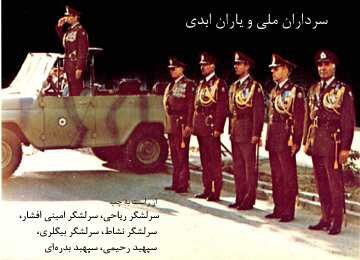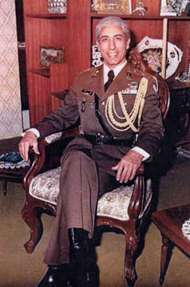English

|
|


From Right to Left: Major General Riyahi, Major General Amini Afshar, Major
General Neshat, Lieutenant General Rahimi, Lieutenant General Badraie
During the late 1970s the
Imperial Iranian Ground Forces, was undergoing a rapid increase
in strength. In 1979 it was a largely mechanized and armored
force of about 285,000 troops, organized in 3 corps, with
headquarters in
Tehran area, in Shiraz in the south, and in
Kermanshah near the Iraq border. There was even Plans for a
fourth corps, to be established at the new Chah Bahar
complex at the eastern end of the Persian Gulf. Major ground
formations included 3 armored divisions (One more in
organization in Sistan) each with six tank battalions and five
mechanized infantry battalions, 3 infantry divisions, 2 Imperial
Guard Divisions and 4 independent brigades (1 armored, 1
infantry, 1 airborne and 1 Special Forces) and the Army Aviation
Command. These combat units, backed up by the usual complement
of support units, were said to be 85 percent operational. During
the mid-1970s fully 80 percent of Iran's ground forces were
deployed along the Iraqi border, though official sources
maintained that a large portion of these could be sent anywhere
in the country within twenty-four hours by means of air force
transports. Troop deployment was expected to shift south during
the late 1970s with the opening of the Chah Bahar facility.
Total (in 1979): 285,000
Reserves: 300,000
Main Unites:
-
16th Armored Division -
Ghazvin
-
81th Armored Division -
Kermanshah
-
92th Armored Division -
Khuzestan
-
88th Armored Division -
Sistan
-
1th Infantry Imperial Guard
Division (After the revolution changed to 21th Infantry
Div.)
-
2th Imperial Guard Division
(After the revolution changed to 21th Infantry Div.)
-
28th Infantry Division -
Kurdistan
-
64th Infantry Division -
Rezaieh
-
77th Infantry Division -
Khorasan
-
84th Infantry Brigade -
Khoramabad (Division during the war with Iraq)
-
55th Airborne Brigade -
Shiraz (Division during the war with Iraq)
-
23th Special forces Brigade
- Nohed -Tehran (Division during the war with Iraq)
-
37th Armored Brigade -
Shiraz
-
11th Artillery Unit
-
22th Artillery Unit
-
23th Artillery Unit
-
44th Artillery Unit
-
55th Artillery Unit
-
Hawk missiles Battalions (4
units)
|
|
Armor
In Imperial Iranian Army |
|
 |
Imperial Iranian Armored units were supplied with medium and
light tanks of American and British origin, and about 1200
Brithish-maded Chieftain tanks were being delivered to augment
the 780 in the inventory. Armored personnel carriers were from
the United States and the Soviet Union and antitank missiles
from the United States and France.
In
1971, Iran placed an order with Royal Ordnance (RO) of the UK
for 707 modified Chieftain Mk 3 and Mk 5 MBTs, plus a quantity
of armoured recovery vehicles (ARVs) and armoured
vehicle-launched bridges (AVLBs) based on the Chieftain MBT
chassis, all of which were delivered by early 1978. Most of
these were built by RO Leeds, subsequently taken over by Vickers
Defence Systems, which built all the ARVs. Iran also took
delivery of 187 improved Chieftains called the FV4030/1 (a
development of the Chieftain Mk 5 used by the British Army) for
it's operational needs. In all, 187 of the FV4030/1, were
supplied.
In 1974, Iran ordered 125 Shir Iran 1 (FV4030/2s) and 1,225 Shir
Iran 2 (FV4030/3s) MBTs for delivery from 1980 - but the order
was cancelled in 1979 after the fall of the Shah and before
deliveries could begin from Royal Ordnance Leeds.
If the Shir 2 MBTs had been delivered, the Iranian Army would
have had the best-protected MBT in the region because the hull
and turret incorporated the advanced Chobham armour system for a
high level of battlefield protection over the frontal arc. In
1979, Jordan bought 274 Shir 1 MBTs, designated the Khalid.
After the Iranian Revolution the "Shir Iran 2" project was taken
over by the British Army and the end result was Challenger later
redesignated as Challenger 1 in service with the British Army
since 1983.
|
|
Tanks |
1971
|
1974
|
1976
|
1977
|
1979
|
|
Scorpion LT |
|
|
|
250
|
250
|
|
M-24 LT |
100
|
|
|
|
|
|
M-47, M-47M MBT |
400
|
400
|
400
|
400
|
160
|
|
M-48, M-48A5 MBT |
|
|
240
|
|
M-60A1 MBT |
460
|
460
|
460
|
460
|
460
|
|
Shir1(Chieftain) MBT |
order
|
60
|
500
|
760
|
780
|
|
APC - Armor Vehicels |
1971
|
1974
|
1976
|
1977
|
1979
|
|
M-8 Armoured Car |
100
|
|
|
|
32
|
|
M-20 Armoured Car |
140
|
|
|
|
48
|
|
Ferret Armoured Car |
|
/
|
/
|
100
|
/
|
|
Fox Armoured Car |
|
|
order
|
|
M-113, M-113A1 APC |
300
|
325
|
564
|
575
|
575
|
|
BTR-40 APC |
|
1425
|
1425
|
1425
|
1425
|
|
BTR-50 APC |
270
|
|
BTR-60 APC |
300
|
|
BTR-152 APC |
|
|
BMP-1 AIFV |
|
|
|
order
|
order
|
* Some M-113 APC are with TOW Missiles
Major Equipment On Order:
-
Shir1 (Chieftain) Tanks -
1971 (800), 1974
(740), 1976 (1480),
1977 (1220)
-
Shir2 (Chieftain) Tanks -1979
(1297)
-
Scorpion Tanks - 1976
(250), 1977 (110),1979
(110)
-
M-113A1 APC - 1979
(108)
-
BMP-1 AIFV - 1979
(x)
|
Shir2 (Challenger 1) MBT - Great Britain
Continued development in the Centurion/Chieftain line to produce
the Shir/Iran 2 originally planned for Iranian forces. After the
Iranian revolution, taken over by the British Army. It has much
more powerful engine than the Chieftain and equipped with
excellent Chobham Armor. Challenger 1 took part in Operation
Desert Storm (1991) where the Iraqi forces failed to take a
single vehicle out of combat while Challenger destroyed roughly
300 Iraqi tanks.
Standard equipment includes thermal sights, gun stabilization
NBC system as well as mounting points for external fuel tanks at
the rear and Combat Dozer Blade at the front.
-
Armament: 1 - 120mm long L11A5 gun, 2 - 7.62mm MG, 2 x 5
barrel smoke dischargers
-
Power Train: Perkins Engines (Shrewsbury) Condor V-12, 12
cyl diesel, coupled to David Brown Vehicle Transmission
TN37.
-
Speed: 34.8 mph
-
Range: 279 miles
-
Crew: 3
-
Weight: 68 tons
|
|
|
Armor in Iranian Army today:
|
-
Chieftain (Shir1) MBT
-
M48/M48A5 MBT
-
M60A1 MBT
-
M47/M47M tank
-
Zulfaqhar MBT
-
T-72 MBT
-
Type 72-Z MBT
-
T-62 MBT
-
T-54/T-55 MBT
-
Type 59 MBT
-
Type 69-2 MBT
-
Safir-74 MBT
-
Scorpion light tank
-
Tosan light tank
|
|
|
|
|
|
|
|
|
اين تار نما را به ياد پدرم، تيمسار سرلشکر علی نشاط، و ساير قهرمانان نيروهای
مسلح شاهنشاهی ايران و جانباختگان راه آزادی پيش کش نمودم
This site is dedicated to my father General Ali Neshat
commander of Imperial Iranian Guards, and to all of the other unsung heroes of
the Imperial Iranian Armed Forces who fell in the name of Iran.
|
|
|
ا |
اين
تارنما هديه ای است به جانباختگان نيرو های سه گانه
|
صدای شما وقتی شنيده می شود که بلند و رسا باشد
|
|
پارسی
 |


